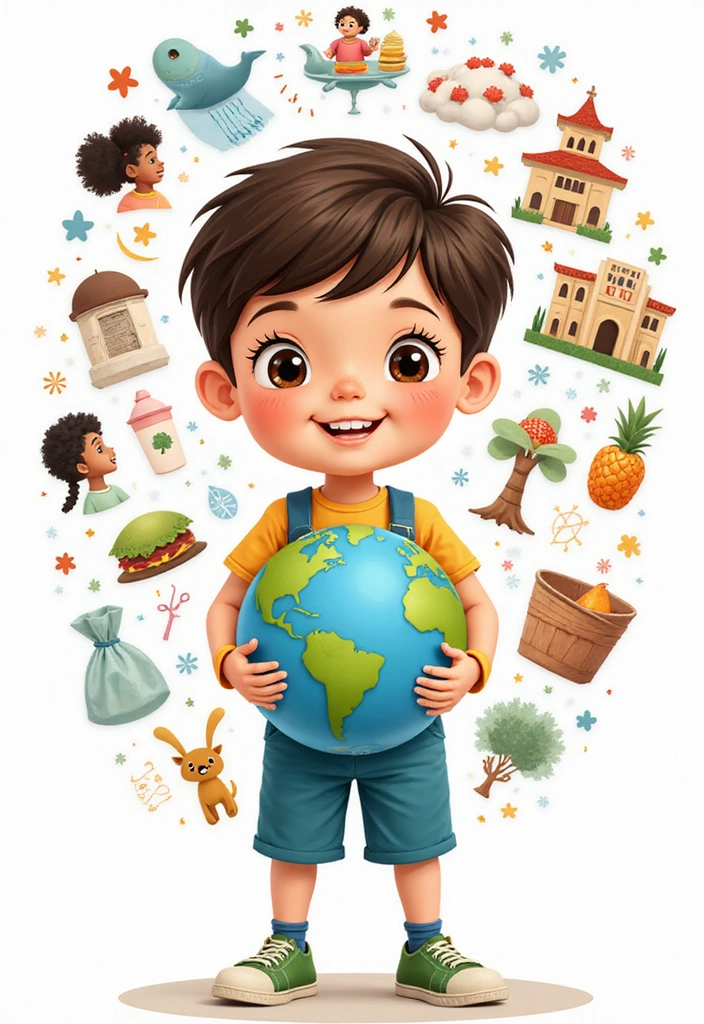Every parent wants their child to grow up to be a force for good in the world. Raising future kids who can make a difference may seem daunting, but it’s often the simple habits and lessons we instill in them that pave the way for greatness.
From encouraging curiosity to fostering creative minds, there are countless ways to nurture your little ones into impactful individuals. The best part? Many of these approaches are easier than you might think! Let’s explore ten practical strategies that will guide you on this rewarding journey of parenting.
Get ready to be inspired and maybe even surprised by some of these tips. Your future world-changers are just waiting for the right support to blossom!
Contents
- 1. Foster Curiosity
- 2. Teach Empathy
- 3. Encourage Creativity
- 4. Model Resilience
- 5. Cultivate a Growth Mindset
- 6. Encourage Environmental Awareness
- 7. Foster Open Communication
- 8. Promote Diversity and Inclusion
- 9. Instill a Sense of Global Responsibility
- 10. Celebrate Their Uniqueness
1. Foster Curiosity

Curiosity is the compass that leads children to discover and innovate. When kids ask questions and explore their surroundings, they build critical thinking skills that prepare them for problem-solving in the future.
Encourage your child to ask ‘why’ and ‘how’—these questions can spark lively discussions. Create a home environment that promotes exploration. This can be as simple as having a variety of books or educational toys available. For instance, consider adding my first library: boxset of 10 board books for kids to your collection. These books provide a wide range of topics that can inspire curiosity and learning.
You can also plan educational outings to museums or nature trails. Moreover, embrace their interests! If they’re fascinated by bugs, engaging them with a magnifying glass for kids allows them to observe their tiny worlds up close. This hands-on experience not only deepens their understanding but also makes exploration exciting.
For those budding scientists, you might want to introduce them to the NATIONAL GEOGRAPHIC amazing chemistry set. This kit comes with over 100 science experiments that inspire creativity and critical thinking while providing a fun, interactive way to learn.
By nurturing their inquisitiveness, you’re laying a strong foundation for lifelong learning. Remember, the more questions they have, the more engaged and enlightened they will become!
2. Teach Empathy

Empathy is an essential trait that can shape a child into a compassionate adult. Instilling empathy is about helping kids understand the feelings of others and showing them the power of kindness.
Start by modeling empathetic behavior. Share stories of kindness, whether from books or your own experiences, and engage your child in conversations about feelings. A wonderful resource for this is Empathy Is Your Superpower: a book about understanding the feelings of others. This book can inspire meaningful discussions and help children grasp the importance of compassion.
Use role-playing to help them navigate different situations and understand various perspectives. A fun way to do this is with Walk Like a Chicken – a no reading required, hide & seek role-playing activity game. This game encourages kids to step into different roles, enhancing their social and emotional understanding.
Get involved in community service together. When children see the impact of helping others, they often develop a deeper appreciation for diverse experiences. Consider exploring the Kid’s Guide to Service Projects: over 500 service ideas for young people who want to make a difference. This guide can help you find engaging activities that promote empathy and community involvement, instrumental in preparing them to be thoughtful leaders in the future.
– Share stories that highlight compassion and understanding.
– Discuss emotions openly to build emotional intelligence.
– Encourage teamwork and collaboration to foster social skills.
3. Encourage Creativity

Creativity is the bedrock of innovation. When children express themselves artistically, they learn to think outside the box and approach challenges with unique solutions.
Set aside time for creative play—this could be painting, building, or even writing stories. Investing in an art supplies set can provide diverse materials for creative expression, allowing them to experiment without the pressure of perfection. Sometimes the messiest projects lead to the greatest discoveries! Encourage them to express their thoughts in different formats, whether it’s through visual art or music.
Consider enhancing their building skills with a building blocks set. These blocks offer endless possibilities for construction and imaginative play, helping them turn mundane moments into imaginative adventures.
Additionally, limit screen time and provide them with materials that stimulate imagination. You can introduce them to music with a set of musical instruments for kids, which can broaden their artistic horizons and nurture their ability to envision a better world while seeking ways to achieve it.
Remember to celebrate their creations without judgment. Attend art or music classes together to further inspire their creative journey. By fostering creativity in your children, you’re equipping them with the tools to change the world.
4. Model Resilience

Resilience is the ability to bounce back from setbacks, and it’s a crucial skill for children if they are to change the world. Modeling resilience starts with showing them how to navigate difficulties with a positive attitude.
Share your own challenges and how you overcame them. This can provide valuable lessons about persistence and adaptability. You might consider introducing them to the Hugging Tree: a story about resilience, a great book that illustrates how to face life’s challenges with courage and resilience.
Create a safe space for your child to articulate their frustrations and encourage them to brainstorm solutions. In moments of failure, focus on the lessons learned rather than the mistakes made. Teach them that every setback is a stepping stone towards success.
Encourage them to try new things, even if there’s a risk of failure. Utilizing the Game Plan life skills for kids board game can be a fun way to encourage problem-solving and feelings management while also building resilience through play.
Celebrate efforts rather than just results. You can also enhance their confidence by introducing the 3 Minute Gratitude journal for kids, which teaches children to practice gratitude and mindfulness, helping them to develop a positive mindset even in challenging situations.
With these tools, you’ll be well on your way to helping your child build resilience and the ability to thrive in the face of adversity.
5. Cultivate a Growth Mindset

A growth mindset is the belief that abilities and intelligence can be developed with effort and persistence. Teaching children this mindset can significantly impact their approach to challenges.
Instead of labeling them as “smart” or “talented,” praise the effort they put into tasks. You might consider using resources like the Growth Mindset Workbook for Kids: 55 Fun Activities to Think Creatively, Solve Problems, and Love Learning. This workbook offers engaging activities that encourage kids to embrace learning as a journey filled with ups and downs, helping them understand that each experience contributes to their growth.
Encourage them to take on challenges instead of shying away from them. When they face obstacles, guide them to reframe their thoughts positively and look for the lessons within those experiences. For example, playing the RAVEL Puzzle Game can help them build resilience and adaptability, as it presents unique solo challenges that require strategic thinking and perseverance.
Additionally, using language that reinforces effort over innate ability is crucial. You could incorporate the Positive Affirmation Cards for Kids into your daily routine. These cards feature inspirational messages that promote confidence, mindfulness, and gratitude, equipping children with the positive mindset needed to tackle challenges head-on.
By integrating these resources into your child’s learning experience, you can nurture a growth mindset that empowers them to embrace challenges and learn from every experience.
6. Encourage Environmental Awareness

Teaching kids about caring for the environment is a vital lesson in shaping future leaders. Start simple by discussing the importance of nature and the impact of our actions on the earth.
Take them outdoors to explore parks, beaches, or forests, allowing them to learn about ecosystems firsthand and sparking their interest in nature preservation. A great way to enhance their outdoor experience is with the Outdoor Exploration Kit, which includes binoculars and various tools for bug catching. This kit encourages curiosity and adventure in nature, making it a fun learning experience.
Get involved in local clean-up efforts or plant trees together to instill a sense of responsibility. You can make sustainability entertaining by incorporating it into daily life through recycling games or gardening projects. A useful tool for these activities is the Kids Gardening Kit, which includes everything from a spade to gloves. It encourages hands-on learning about plants and the environment, showing them how small actions can lead to significant changes.
Additionally, use engaging materials like Environmental Awareness Books for Kids to discuss environmental issues. These resources can spark conversations and deepen their understanding of the importance of conservation.
– Involve them in nature-related activities that promote conservation.
– Encourage them to make eco-friendly choices.
– Use documentaries or books to enhance their awareness.
7. Foster Open Communication

One of the most surprisingly easy ways to empower future kids is through open communication. When children feel safe to express their thoughts and feelings, they develop confidence and leadership skills.
Make it a habit to regularly check in with your child about their day, thoughts, and emotions. Using open-ended questions can invite them into conversations, fostering a sense of connection and boosting their emotional intelligence. A great tool to facilitate this is the Family Conversation Starter Cards. These cards are designed to help your family engage in meaningful dialogue, allowing kids to express themselves while strengthening your bonds during dinner or road trips.
Creating a judgment-free zone encourages them to share their ideas, no matter how big or small. Be an active listener; acknowledging their feelings and responding thoughtfully is crucial. To enhance your active listening skills, consider using the Active Listening Skills Workbook. This journal provides exercises and prompts that can help you refine your listening techniques, ensuring your child feels heard and understood.
Additionally, normalizing conversations about feelings can be made easier with the Emotion Chart for Kids. This chart can serve as a visual aid, helping kids identify and articulate their emotions, which can be particularly useful in guiding discussions about their feelings.
By practicing effective communication, you’re equipping them with the skills to collaborate and advocate for themselves and others.
8. Promote Diversity and Inclusion

Raising children who can change the world means teaching them about diversity and the importance of inclusion. Help them understand and appreciate various cultures, backgrounds, and perspectives through engaging resources. For instance, introducing them to It’s OK to be Different: a children’s picture book about diversity and kindness can spark conversations about what it means to embrace our differences and foster kindness among peers.
Expose them to different communities and encourage friendships with peers from various backgrounds. Music can be a powerful way to explore cultural diversity, and a great addition to your collection is the World Playground CD, which introduces a variety of global sounds that can enrich their understanding of the world.
Additionally, discussing the value of every individual, regardless of their differences, can be made fun and educational with games like the Continent Race geography educational board game. This interactive way of learning about flags and countries will not only entertain but also teach kids about global cultures and diversity.
Engage in conversations about social justice and equality. Encourage them to stand up for what’s right and to challenge stereotypes. By embracing diversity, you’re helping them cultivate empathy and a sense of responsibility towards others.
– Create a diverse environment through media and cultural experiences.
– Encourage discussions about equality and inclusivity.
– Support community events that celebrate diversity.
9. Instill a Sense of Global Responsibility

Teaching kids to think globally is essential in our interconnected world. Start by discussing global issues like poverty, climate change, and social justice to help them understand how their actions can impact the world. A great resource for this is Belly Ache-y!: From Hungry Tummies to Full Bellies! (Global Series Book 9), which can introduce them to pressing global issues in a way that’s engaging and accessible.
Get involved in global initiatives together, like fundraisers or awareness campaigns. Show them how even small contributions can lead to significant change. For instance, you might consider gifting them a fair trade chocolate gift box. This not only supports ethical practices but also allows your kids to see how their choices can contribute to broader change.
Encourage them to think beyond their immediate surroundings—this could be as simple as discussing the importance of fair trade or sharing the stories of children in different countries. Engaging with tools like an Imagimake Mapology USA & World Map Puzzle can further spark their interest in geography and global cultures. By fostering this sense of global responsibility, you’re shaping compassionate citizens who care about the world around them.
10. Celebrate Their Uniqueness

Every child is unique, and embracing their individuality is crucial in helping them realize their potential. Celebrate their quirks, interests, and talents, and encourage them to be proud of who they are.
Provide opportunities for them to explore their passions, whether it’s sports, art, or science. For the creative ones, an art supplies set can help them unleash their imagination and express themselves freely. Celebrate their achievements, big or small, to boost their self-esteem. For kids who may benefit from a little confidence boost, consider books like self-esteem building books for kids that teach them to use words to empower themselves.
By affirming their uniqueness, you empower them to embrace their identities and contribute their distinct voices to the world. If they lean towards sports, a sports equipment for kids, such as a trainer for soccer or volleyball, can help them practice skills and gain confidence in their athletic abilities.
Encourage them to be advocates for themselves and others. This self-confidence is key in helping them navigate a world that often tries to fit them into molds. Create a positive environment that celebrates individuality and fosters self-advocacy skills to empower their voice.
Conclusion

Raising future kids who can change the world is an incredible journey that begins with simple, intentional actions. By fostering curiosity, empathy, creativity, and resilience, you’re nurturing the leaders of tomorrow.
Remember that every small step counts towards making a significant impact. As you implement these strategies, you’re not just preparing your children for the future; you’re empowering them to shape it for the better. Why not embrace this rewarding adventure today?
Note: We aim to provide accurate product links, but some may occasionally expire or become unavailable. If this happens, please search directly on Amazon for the product or a suitable alternative.
This post contains Amazon affiliate links, meaning I may earn a small commission if you purchase through my links, at no extra cost to you.



